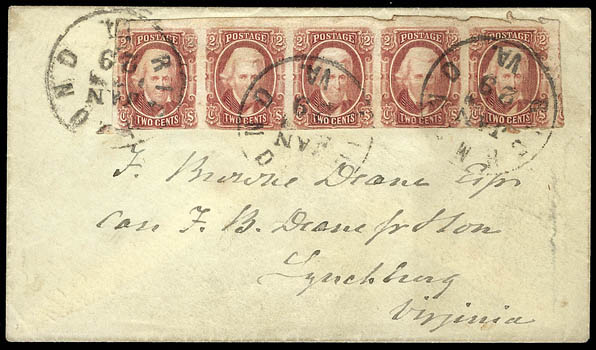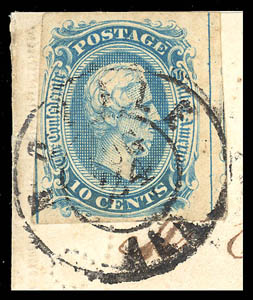
Lot
93 
Confederacy, 1863, 2¢ Brown Red, Two Singles on Forwarded Cover. Single (large margins to just shaving at top) tied by Greenville C.H., S.C. (1864) cds on wrapper to Columbia, S.C. paying the 2¢ circular rate, wrapper then forwarded back to Greenville and additionally franked with second 2¢ Red Jack in superb condition with large even margins, tied by blue "Columbia, S.C./Apr. 7" cds, Extremely Fine and choice, The two different shades of red brown make a lovely contrast. This rare usage of two 2¢ Red Jacks is unique and extremely desirable. ex-Cantey, Haas (Pictured in Monroe Book, pg. 65). Scott No. 8 Estimate $3,000 - 4,000.
This stunning cover has a 2001 C.S.A. Authentication Service certificate and was acquired from the late Colonel Edward B. Cantey, Jr. collection. It was the subject of an article in the January-March 2009 issue of The Confederate Philatelist.
Realized: $9,000

Lot
94 
Confederacy, 1863, 2¢ Brown Red, Horitonal Strip of 5. The 4th stamp in strip show the "Double Transfer" variety, three large margins to just touching at bottom, deep rich color, tied by three strikes of "Richmond, Va./Jan. 29" (1865) cds on cover to Lynchburg, Va., Very Fine and rare, A Gorgeous Cover Bearing a Strip of 5 To Pay the 10¢ Letter Rate (Pictured in Monroe Book, pg. 64); with 2003 C.S.A. certificate. Scott No. 8 Estimate $2,000 - 3,000.
Realized: $2,200

Lot
95 
Confederacy, 1863, 10¢ Blue, "T-E-N", Corner Margin Single. Top left corner margin single with large margins on other sides, fresh, bright color, tied by "Polland, Ala./Sep. 9, 1863" cds on neat blue cover to Fort Deposte, Ala., included is a 50¢ Confederate banknote showing the same portrait as used on the "TEN" adhesive, Extremely Fine and attractive, one of the finest examples on cover, ex-A. Hall (Pictured in Monroe Book, pg. 66); with 1992 C.S.A. certificate. Scott No. 9 Estimate $1,000 - 1,500.
Realized: $2,400


Lot
96 
Confederacy, 1863, 10¢ Blue, "Frame Lines". Four large margins including full frameline at right and 40% at left, tied by "Mobile, Ala./Aug. 24" double circle postmark on fancy embossed ladies cover to Augusta, Ga., Extremely Fine and attractive, a gorgeous frameline cover (Pictured in Monroe Book, pg. 67). Scott No. 10 Estimate $1,500 - 2,000.
Realized: $2,100

Lot
97 
Confederacy, 1863, 10¢ Blue. Large even margins, deep color tied by blue "Columbia, S.C./Oct. 10" cds on cover with "Southern Express Company's Telegraph" imprint on telegraph delivery cover to Glen Springs, S.C., Extremely Fine and choice, a gorgeous cover, ex-Judd (Pictured in Monroe Book, pg. 49). Scott No. 11 Estimate $750 - 1,000.
This interesting cover highlights the fact that the Southern Express Company, in addition to providing the traditional express services, it also provided telegraph service throughout the Confederacy. Using the services of the Southern Express Company, a telegram was sent to a lady in Glenn Springs, South Carolina. The company's nearest office to Glenn Springs was Columbia, South Carolina, so the telegram was evidently wired to that location, written up and promptly mailed to the recipient. Mrs. C. E. Winsmith.
The sender is most likely Captain J. C. Winsmith who was wounded in the right shoulder at Fort Harrison, Virginia, on September 30,1864. Captain Winsmith is possibly notifying his family of the wound and his convalescing at General Hospital #4 in Richmond, Virginia. He survived the wound (his second) and was discharged on October 26, 1864.
A postally used, Southern Express Company imprinted telegraph envelope is very scarce.
Realized: $4,000

Lot
98 
Confederacy, 1863, 10¢ Blue. Huge even margins, neatly tied by "Anderson, Tex./Jan. 19" balloon cds on turned cover to Wm. H. Neblett of Capt. Stephenson's Co. D, Col. Elmore's Regt. in Galveston, inside usage shows Austin, Tex. double circle postmark & "Paid 5" handstamps (Deitz type IA) addressed to Corsicana, Tex., Extremely Fine, a nice Texas turned usage with interesting military address (Pictured in Monroe Book, pg. 19). Scott No. 11 Estimate $300 - 400.
Colonel Henry M. Elmore's Regiment was the 20th Texas Infantry regiment which was organized in Galveston and Assigned to the Trans-Mississippi Department. It consisted of a high percentage of middle-aged men who performed guard duty along the coast from Galveston to the Sabine River.
On the envelope there is an interesting pencil notation, "Don't send another negro. If they come after them conscript Joe. But they have no right. Planting corn will not prevent imprisonment.".
Realized: $1,050

Lot
99 
Confederacy, 1863, 10¢ Blue. two immaculate covers each franked with 10¢ single, one with #11 & other with #12, both from same correspondence from R. Habersham & Sons in Savannah to Charles Manigault in Charleston, first is 10¢ (#11, mostly large margins), tied by "Savannah, Ga./Aug. 13/Paid" cds, second is 10¢ (#12, large even margins, small defect) tied by "Savannah, Ga./May 19" cds, Extremely Fine (Pictured in Monroe Book, pg. 19/20). Scott No. 11-12 Estimate $150 - 200.
Charles Manigault (1795-1874), was a prominent plantation owner, who has been described as a "gentleman capitalist" and "cosmopolitan." He spoke French and prided himself on his wealth and social status. Manigault owned "Gowrie" and "East Hermitage" plantations, located on Argyle Island in the Savannah River, several miles upstream from the port of Savannah. He purchased "Gowrie" in 1833 for $49,500, by 1861 the plantation was worth $266,000.
Realized: $230

Lot
100 
Confederacy, 1863, 10¢ Blue. Two large margin singles, tied by two strikes of "Charleston, S.C./Sep. 29, 186" (1863) cds on double rate cover to Greenville, S.C., Extremely Fine and attractive (Pictured in Monroe Book, pg. 21). Scott No. 11 Estimate $150 - 200.
Realized: $120

Lot
101 
Confederacy, 1863, 10¢ Blue. Four large margins, tied by "Charleston, S.C./Aug. 23" double circle postmark on 1864 cover to "Lieutenant Launcelot M. Blackford, Military Court, Hd. Qua. Lt. Gen. Longstreet, Army of Northern Va.", Extremely Fine, Lieut. Blackford, was one of five brothers who served in the Confederate Army. Remarkably, all five survived the war. Featured in the Confederate Philatelist (Jul.-Aug. '76) (Pictured in Monroe Book, pg. 21). Scott No. 11 Estimate $100 - 150.
Realized: $290

Lot
102 
Confederacy, 1863, 10¢ Blue, Perforated. Rich color, tied by "Montgomery Ala./Oct. 8" cds on small pink cover to Montgomery, overpaid drop rate but probably mailed outside Montgomery and postmarked on arrival, Extremely Fine, a choice perforated usage on this pristine cover, ex-Brooks, Everett and Hill (Pictured in Monroe Book, pg. 75). Scott No. 11e Estimate $750 - 1,000.
There were no "officially" perforated Confederate postage stamps. However, there were stamps that were perforated by Confederate Post Office Department officials for experimental purposes. William C. Stone, in a discussion with August Dietz many decades ago, covered this situation most succinctly in his statement: "Stamps were perforated by officials, but not officially."
The following is a quote from August Dietz regarding the facts surrounding the "official" perforations:
H. St. George Offutt, and a number of officials of the Post Office Department, on receipt of the small perforating machine from England, gave the device a try-out on some sheets of stamps from stock. The experiment proved unsatisfactory, both on account of the slow process of piercing a single row at each operation, and because of gum "clogging" the counters; whereupon perforating was definitely abandoned. Inasmch as these sheets could not be destroyed, for obvious reasons, they were put back into stock, and issued to postmasters, on requisition, along with the imperforate sheets. In this manner they found their way into the hands of the public.
Realized: $1,000
